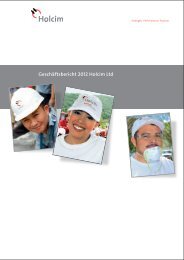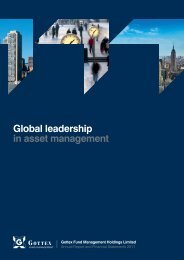Transocean Proxy Statement and 2010 Annual Report
Transocean Proxy Statement and 2010 Annual Report
Transocean Proxy Statement and 2010 Annual Report
Create successful ePaper yourself
Turn your PDF publications into a flip-book with our unique Google optimized e-Paper software.
The following table <strong>and</strong> narrative disclosure set forth certain information with respect to pension<br />
benefits payable to the Named Executive Officers pursuant to these plans:<br />
Payments<br />
Number Present Value During<br />
of Years of Last<br />
Credited Accumulated Fiscal<br />
Service Benefit Year<br />
Name Plan Name (#) ($) ($)<br />
Steven L. Newman <strong>Transocean</strong> U.S. Retirement Plan 17 335,905 0<br />
<strong>Transocean</strong> Pension Equalization Plan 17 1,497,623 0<br />
Ricardo H. Rosa <strong>Transocean</strong> International Retirement Plan 11 521,592 0<br />
<strong>Transocean</strong> Management Ltd. Pension Plan 2 135,310 0<br />
Eric B. Brown <strong>Transocean</strong> U.S. Retirement Plan 16 711,293 0<br />
<strong>Transocean</strong> Pension Equalization Plan 16 1,760,697 0<br />
Arnaud A. Y. Bobillier <strong>Transocean</strong> International Retirement Plan 2 18,707 0<br />
<strong>Transocean</strong> Management Ltd. Pension Plan 2 80,539 0<br />
Ihab M. Toma <strong>Transocean</strong> International Retirement Plan 1 86,452 0<br />
<strong>Transocean</strong> Management Ltd. Pension Plan 1 59,998 0<br />
Robert L. Long <strong>Transocean</strong> U.S. Retirement Plan 31 1,449,298 0<br />
<strong>Transocean</strong> Pension Equalization Plan 31 13,592,587 0<br />
Cheryl D. Richard <strong>Transocean</strong> U.S. Retirement Plan 7 181,724 0<br />
<strong>Transocean</strong> Pension Equalization Plan<br />
<strong>Transocean</strong> Supplemental Executive<br />
7 917,386 917,386<br />
Retirement Plan 7 2,148,187 2,148,187<br />
<strong>Transocean</strong> U.S. Retirement Plan<br />
The <strong>Transocean</strong> U.S. Retirement Plan is a tax-qualified pension plan funded through cash<br />
contributions made by the Company based on actuarial valuations <strong>and</strong> regulatory requirements.<br />
Messrs. Newman, Brown <strong>and</strong> Long <strong>and</strong> Ms. Richard were the Named Executive Officers in <strong>2010</strong> who have<br />
historically participated in this plan. The purpose of the plan is to provide post-retirement income benefits<br />
to employees in recognition of their long-term service to the Company. Employees working for the<br />
Company in the U.S. are fully vested after completing five years of eligible employment. Benefits available<br />
to the Named Executive Officers are no greater than those offered to non-executive participants.<br />
Employees earn the right to receive a benefit upon retirement at the normal retirement age of 65 or upon<br />
early retirement (age 55 or older). The plan was amended effective January 1, 2009 to eliminate the<br />
30 year lifetime cap on credited service.<br />
Credited service under the plan includes all periods of employment after June 30, 1993, except for<br />
such periods when an employee does not meet eligibility requirements under the plan.<br />
The following elements of executive compensation are included in computing the retirement benefit:<br />
base salary, non-equity incentive plan compensation <strong>and</strong> special performance cash bonuses. Retirement<br />
benefits are calculated as (1) the product of (A) each year of an employee’s credited service (with a<br />
maximum of 30 years of credited service), times (B) 2.00%, times (C) the final average earnings, minus<br />
(2) the product (also referred to as the ‘‘Offset’’) of (A) each year of an employee’s credited service (with a<br />
maximum of 30 years of credited service), times (B) 0.65%, times (C) the final average social security<br />
earnings. However, the Offset cannot be greater than one-half of the gross benefit, calculated using the<br />
lesser of the final average earnings <strong>and</strong> final average social security earnings.<br />
If the employee elects to retire between the ages of 55 <strong>and</strong> 64, the amount of benefits is reduced;<br />
actuarial reduction factors are applied to his ‘‘gross benefit’’ <strong>and</strong> his final average social security earnings<br />
P-64

















